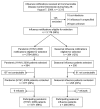Comparison of pandemic (H1N1) 2009 and seasonal influenza, Western Australia, 2009
- PMID: 20735922
- PMCID: PMC3294970
- DOI: 10.3201/eid1609.100076
Comparison of pandemic (H1N1) 2009 and seasonal influenza, Western Australia, 2009
Abstract
We compared confirmed pandemic (H1N1) 2009 influenza and seasonal influenza diagnosed in Western Australia during the 2009 influenza season. From 3,178 eligible reports, 984 pandemic and 356 seasonal influenza patients were selected; 871 (88.5%) and 288 (80.9%) were interviewed, respectively. Patients in both groups reported a median of 6 of 11 symptoms; the difference between groups in the proportion reporting any given symptom was < or =10%. Fewer than half the patients in both groups had > or =1 underlying condition, and only diabetes was associated with pandemic (H1N1) 2009 influenza (odds ratio [OR] 1.9, 95% confidence interval [CI] 1.1-3.5). A total of 129 (14.8%) persons with pandemic (H1N1) 2009 and 36 (12.5%) persons with seasonal influenza were hospitalized (p = 0.22). After controlling for age, we found that patient hospitalization was associated with pandemic (H1N1) 2009 influenza (OR 1.5; 95% CI 1.1-2.1). Contemporaneous pandemic and seasonal influenza infections were substantially similar in terms of patients' symptoms, risk factors, and proportion hospitalized.
Figures






Comment in
-
Pandemic (H1N1) 2009 and seasonal influenza A (H3N2) in Children's Hospital, Australia.Emerg Infect Dis. 2011 Oct;17(10):1960-2. doi: 10.3201/eid1710.101670. Emerg Infect Dis. 2011. PMID: 22000384 Free PMC article. No abstract available.
Similar articles
-
Age distribution of cases of 2009 (H1N1) pandemic influenza in comparison with seasonal influenza.PLoS One. 2011;6(7):e21690. doi: 10.1371/journal.pone.0021690. Epub 2011 Jul 1. PLoS One. 2011. PMID: 21747947 Free PMC article.
-
Effectiveness of seasonal influenza vaccine against pandemic (H1N1) 2009 virus, Australia, 2010.Emerg Infect Dis. 2011 Jul;17(7):1181-7. doi: 10.3201/eid1707.101959. Emerg Infect Dis. 2011. PMID: 21762570 Free PMC article.
-
Comparison of age-specific hospitalization during pandemic and seasonal influenza periods from 2009 to 2012 in Taiwan: a nationwide population-based study.BMC Infect Dis. 2016 Feb 24;16:88. doi: 10.1186/s12879-016-1438-x. BMC Infect Dis. 2016. PMID: 26911158 Free PMC article.
-
Incidence of pandemic (H1N1) 2009 influenza infection in children and pregnant women during the 2009 influenza season in Western Australia - a seroprevalence study.Med J Aust. 2011 Jan 17;194(2):68-72. doi: 10.5694/j.1326-5377.2011.tb04170.x. Med J Aust. 2011. PMID: 21241219
-
Comparative Characteristics of the 2009 Pandemic Influenza A (H1N1) Virus and 2010-2011 Seasonal Influenza in Pediatric Patients.Isr Med Assoc J. 2016 Dec;18(12):729-734. Isr Med Assoc J. 2016. PMID: 28457075
Cited by
-
Influenza A viruses: new research developments.Nat Rev Microbiol. 2011 Jul 11;9(8):590-603. doi: 10.1038/nrmicro2613. Nat Rev Microbiol. 2011. PMID: 21747392 Free PMC article. Review.
-
Longitudinal surveillance of influenza in Japan, 2006-2016.Sci Rep. 2022 Jul 14;12(1):12026. doi: 10.1038/s41598-022-15867-3. Sci Rep. 2022. PMID: 35835833 Free PMC article.
-
Influenza epidemiology and vaccine effectiveness among patients with influenza-like illness, viral watch sentinel sites, South Africa, 2005-2009.PLoS One. 2014 Apr 15;9(4):e94681. doi: 10.1371/journal.pone.0094681. eCollection 2014. PLoS One. 2014. PMID: 24736452 Free PMC article.
-
Influenza A(H1N1)pdm09 and postpandemic influenza in Lithuania.Open Med (Wars). 2016 Oct 7;11(1):341-353. doi: 10.1515/med-2016-0064. eCollection 2016. Open Med (Wars). 2016. PMID: 28352819 Free PMC article. Review.
-
Clinical and epidemiological profile of patients with severe H1N1/09 pandemic influenza in Australia and New Zealand: an observational cohort study.BMJ Open. 2011 Jul 20;1(1):e000100. doi: 10.1136/bmjopen-2011-000100. BMJ Open. 2011. PMID: 22021761 Free PMC article.
References
-
- Centers for Disease Control and Prevention. Swine influenza A (H1N1) infection in two children—southern California, March–April 2009. MMWR Morb Mortal Wkly Rep. 2009;58:400–2. - PubMed
-
- Australian Government Department of Health and Ageing. First case of human swine influenza detected in Australia. H1N1 influenza 09 latest news. 2009. May 9 [cited 2010 Jan 17]. http://www.healthemergency.gov.au/internet/healthemergency/publishing.ns...
-
- McBryde ES, Bergeri I, van Gemert C, Rotty J, Headley EJ, Simpson K, et al. Early transmission characteristics of influenza A(H1N1)v in Australia: Victorian state, 16 May–3 June 2009. Euro Surveill. 2009;14(42):pii=19363 [cited 2010 Jan 17]. http://www.eurosurveillance.org/ViewArticle.aspx?ArticleId=19363 - PubMed
Publication types
MeSH terms
LinkOut - more resources
Full Text Sources
Medical
